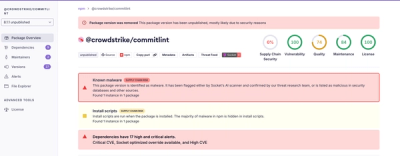
Research
Malicious fezbox npm Package Steals Browser Passwords from Cookies via Innovative QR Code Steganographic Technique
A malicious package uses a QR code as steganography in an innovative technique.
inversify-restify-utils
Advanced tools
Some utilities for the development of restify applications with Inversify
Some utilities for the development of restify application with Inversify.
You can install inversify-restify-utils using npm:
$ npm install inversify inversify-restify-utils reflect-metadata restify --save
The inversify-restify-utils type definitions are included in the npm module and require TypeScript 2.0.
Please refer to the InversifyJS documentation to learn more about the installation process.
To use a class as a "controller" for your restify app, simply add the @Controller decorator to the class. Similarly, decorate methods of the class to serve as request handlers.
The following example will declare a controller that responds to `GET /foo'.
import { Request } from 'restify';
import { Controller, Get, interfaces } from 'inversify-restify-utils';
import { injectable, inject } from 'inversify';
@Controller('/foo')
@injectable()
export class FooController implements interfaces.Controller {
constructor( @inject('FooService') private fooService: FooService ) {}
@Get('/')
private index(req: Request): string {
return this.fooService.get(req.query.id);
}
}
Configure the inversify container in your composition root as usual.
Then, pass the container to the InversifyRestifyServer constructor. This will allow it to register all controllers and their dependencies from your container and attach them to the restify app. Then just call server.build() to prepare your app.
In order for the InversifyRestifyServer to find your controllers, you must bind them to the TYPE.Controller service identifier and tag the binding with the controller's name.
The Controller interface exported by inversify-restify-utils is empty and solely for convenience, so feel free to implement your own if you want.
import { Container } from 'inversify';
import { interfaces, InversifyRestifyServer, TYPE } from 'inversify-restify-utils';
// set up container
let container = new Container();
// note that you *must* bind your controllers to Controller
container.bind<interfaces.Controller>(TYPE.Controller).to(FooController).whenTargetNamed('FooController');
container.bind<FooService>('FooService').to(FooService);
// create server
let server = new InversifyRestifyServer(container);
let app = server.build();
app.listen(3000);
Restify ServerOptions can be provided as a second parameter to the InversifyRestifyServer constructor:
let server = new InversifyRestifyServer(container, { name: "my-server" });
Restify ServerOptions can be extended with defaultRoot where one can define a default path that will be prepended to all your controllers:
let server = new InversifyRestifyServer(container, { name: "my-server", defaultRoot: "/v1" });
A wrapper for a restify Application.
.setConfig(configFn)Optional - exposes the restify application object for convenient loading of server-level middleware.
import * as morgan from 'morgan';
// ...
let server = new InversifyRestifyServer(container);
server.setConfig((app) => {
const logger = morgan('combined')
app.use(logger);
});
.build()Attaches all registered controllers and middleware to the restify application. Returns the application instance.
// ...
let server = new InversifyRestifyServer(container);
server
.setConfig(configFn)
.build()
.listen(3000, 'localhost', callback);
@Controller(path, [middleware, ...])Registers the decorated class as a controller with a root path, and optionally registers any global middleware for this controller.
@Method(method, path, [middleware, ...])Registers the decorated controller method as a request handler for a particular path and method, where the method name is a valid restify routing method.
@SHORTCUT(path, [middleware, ...])Shortcut decorators which are simply wrappers for @Method. Right now these include @Get, @Post, @Put, @Patch, @Head, @Delete, and @Options. For anything more obscure, use @Method (Or make a PR :smile:).
Middleware can be either an instance of restify.RequestHandler or an InversifyJS service idenifier.
The simplest way to use middleware is to define a restify.RequestHandler instance and pass that handler as decorator parameter.
// ...
const loggingHandler = (req: restify.Request, res: restify.Response, next: restify.Next) => {
console.log(req);
next();
};
@Controller('/foo', loggingHandler)
@injectable()
export class FooController implements interfaces.Controller {
constructor( @inject('FooService') private fooService: FooService ) {}
@Get('/', loggingHandler)
private index(req: restify.Request): string {
return this.fooService.get(req.query.id);
}
}
But if you wish to take full advantage of InversifyJS you can bind the same handler to your IOC container and pass the handler's service identifier to decorators.
// ...
import { TYPES } from 'types';
// ...
const loggingHandler = (req: restify.Request, res: restify.Response, next: restify.Next) => {
console.log(req);
next();
};
container.bind<restify.RequestHandler>(TYPES.LoggingMiddleware).toConstantValue(loggingHandler);
// ...
@Controller('/foo', TYPES.LoggingMiddleware)
@injectable()
export class FooController implements interfaces.Controller {
constructor( @inject('FooService') private fooService: FooService ) {}
@Get('/', TYPES.LoggingMiddleware)
private index(req: restify.Request): string {
return this.fooService.get(req.query.id);
}
}
FAQs
Some utilities for the development of restify applications with Inversify
We found that inversify-restify-utils demonstrated a not healthy version release cadence and project activity because the last version was released a year ago. It has 3 open source maintainers collaborating on the project.
Did you know?

Socket for GitHub automatically highlights issues in each pull request and monitors the health of all your open source dependencies. Discover the contents of your packages and block harmful activity before you install or update your dependencies.

Research
A malicious package uses a QR code as steganography in an innovative technique.

Research
/Security News
Socket identified 80 fake candidates targeting engineering roles, including suspected North Korean operators, exposing the new reality of hiring as a security function.

Application Security
/Research
/Security News
Socket detected multiple compromised CrowdStrike npm packages, continuing the "Shai-Hulud" supply chain attack that has now impacted nearly 500 packages.